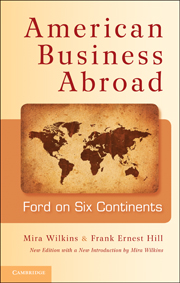Book contents
- Frontmatter
- Contents
- List of Illustrations
- Preface
- Introduction to the New Edition
- Introduction to the First Edition
- 1 First Venture
- 2 Probing for Markets
- 3 Model T: Triumph and Fable
- 4 The Alchemy of War
- 5 Steps in Expansion
- 6 The Sun Never Sets
- 7 Prosperity and Frustration
- 8 The Missionary Spirit
- 9 The Best-Laid Plans
- 10 Marriage of Convenience
- 11 Time of Desperation
- 12 A World Disturbed
- 13 Extreme of Nationalism
- 14 The British Empery
- 15 On Both Sides of World War II
- 16 The Crippled Phoenix
- 17 The New Company
- 18 Manufacturing for World Markets: From Dagenham to Geelong
- 19 New Times, New Faces, New Policies
- Appendices
- Bibliographical Essay
- Notes
- Index
- Titles in the series
- Plate section
18 - Manufacturing for World Markets: From Dagenham to Geelong
Published online by Cambridge University Press: 05 June 2012
- Frontmatter
- Contents
- List of Illustrations
- Preface
- Introduction to the New Edition
- Introduction to the First Edition
- 1 First Venture
- 2 Probing for Markets
- 3 Model T: Triumph and Fable
- 4 The Alchemy of War
- 5 Steps in Expansion
- 6 The Sun Never Sets
- 7 Prosperity and Frustration
- 8 The Missionary Spirit
- 9 The Best-Laid Plans
- 10 Marriage of Convenience
- 11 Time of Desperation
- 12 A World Disturbed
- 13 Extreme of Nationalism
- 14 The British Empery
- 15 On Both Sides of World War II
- 16 The Crippled Phoenix
- 17 The New Company
- 18 Manufacturing for World Markets: From Dagenham to Geelong
- 19 New Times, New Faces, New Policies
- Appendices
- Bibliographical Essay
- Notes
- Index
- Titles in the series
- Plate section
Summary
“For the British Motor Industry, 1954 was another year of tremendous expansion,” Sir Rowland Smith, now chairman of the Board, told his Ford Ltd. stockholders in the annual report for that period. “More than a million cars and trucks were produced in this country by the Industry as a whole, and we played a leading part in this achievement.” The statement was no exaggeration. Dagenham had sold 297,768 vehicles in the past twelve months, more than three times its 1939 total. Over half its products (155,496) were being sold abroad, and its domestic production, freed from governmental fetters, was rapidly expanding.
Its dramatic rise was part of a massive movement by the entire automobile industry of Europe. Stimulated by the Marshall Plan, the Western nations had shown dynamic productive strength, in which the automotive output shared. While England was building more than a million units, Germany manufactured more than 700 thousand, France 600 thousand, and Italy 217 thousand. The sum total of foreign output amounted to less than half the 6.6 million vehicles built by American factories, but it represented a startling upsurge. How had it come about in a world which some prophets had felt was saturated with cars even as early as 1949?
There had been no saturation, but rather an ascending curve of production and buying. Ford-England illustrates what had happened.
In 1950 the English government limited the total output of all firms for home consumption to 110,000 cars.
- Type
- Chapter
- Information
- American Business AbroadFord on Six Continents, pp. 380 - 405Publisher: Cambridge University PressPrint publication year: 2011

